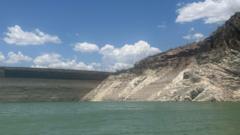As communities in northern Mexico grapple with a relentless drought, the ongoing water-sharing conflict between the US and Mexico worsens. In the town of San Francisco de Conchos, residents come together in prayer, beseeching for rain that has eluded them for over two and a half years. Once submerged under Lake Toronto, the dry, cracked earth displays the critical depletion of water levels in the reservoir, a situation closely monitored by local expert Rafael Betance, who has dedicated decades to tracking the dam's condition.
Currently, the water held in Lake Toronto rests at just 14% of its total capacity, putting immense pressure on the area's agricultural and domestic water needs. Amid the sweltering heat and dire circumstances, a long-standing dispute over water resources, rooted in a 1944 treaty, threatens to become contentious. Under this agreement, Mexico is required to supply the US with annual water allocations from the Rio Grande, a commitment that has become increasingly challenging to meet given the drought.
On their side of the border, Texas farmers express frustration over Mexico's alleged failure to comply with the water-sharing agreement. Brian Jones, a farmer in the Rio Grande Valley, notes that he has only been able to cultivate a fraction of his land due to insufficient irrigation. He argues that water is rightfully due to them under the treaty and accuses Mexico of "hoarding" precious resources while their own farmers continue to grow crops.
Conversely, Mexican farmers, such as Jaime Ramirez, argue that the treaty's requirements are unsustainable given the ongoing drought conditions. While some farming methods in Chihuahua have remained traditional and water-consuming, efforts toward modernization and efficiency—like installing sprinkler systems—have gained traction among forward-thinking farmers. Ramirez emphasizes the need for understanding among farmers on both sides of the border.
As drought conditions persist, many believe the 1944 agreement needs urgent reevaluation to address the realities of climate change and population growth. However, on both sides, tensions remain high. The need for water conservation and sustainable agricultural practices has never been more pressing, reflecting a dire outlook that looms over the valley's communities. Without rain, local leaders believe there may be little left to support agriculture, urging collective efforts to navigate a future reliant on careful and equitable management of shared water resources. With community prayers for rainfall echoing in the parched landscape, the looming question remains: can both nations find common ground amidst escalating water challenges?




















